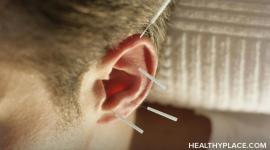Manipulative and Body-Based Practices: An Overview

Do alternative therapies such as chiropractic manipulation, massage therapy, reflexology or rolfing really improve your mental health? Here's what the science says.
On this page
- Introduction
- Scope of the Research
- Summary of the Major Threads of Evidence
- Definitions
- For More Information
- References
Introduction
Under the umbrella of manipulative and body-based practices is a heterogeneous group of CAM interventions and therapies. These include chiropractic and osteopathic manipulation, massage therapy, Tui Na, reflexology, rolfing, Bowen technique, Trager bodywork, Alexander technique, Feldenkrais method, and a host of others (a list of definitions is given at the end of this report). Surveys of the U.S. population suggest that between 3 percent and 16 percent of adults receive chiropractic manipulation in a given year, while between 2 percent and 14 percent receive some form of massage therapy.1-5 In 1997, U.S. adults made an estimated 192 million visits to chiropractors and 114 million visits to massage therapists. Visits to chiropractors and massage therapists combined represented 50 percent of all visits to CAM practitioners.2 Data on the remaining manipulative and body-based practices are sparser, but it can be estimated that they are collectively used by less than 7 percent of the adult population.
Manipulative and body-based practices focus primarily on the structures and systems of the body, including the bones and joints, the soft tissues, and the circulatory and lymphatic systems. Some practices were derived from traditional systems of medicine, such as those from China, India, or Egypt, while others were developed within the last 150 years (e.g., chiropractic and osteopathic manipulation). Although many providers have formal training in the anatomy and physiology of humans, there is considerable variation in the training and the approaches of these providers both across and within modalities. For example, osteopathic and chiropractic practitioners, who use primarily manipulations that involve rapid movements, may have a very different treatment approach than massage therapists, whose techniques involve slower applications of force, or than craniosacral therapists. Despite this heterogeneity, manipulative and body-based practices share some common characteristics, such as the principles that the human body is self-regulating and has the ability to heal itself and that the parts of the human body are interdependent. Practitioners in all these therapies also tend to tailor their treatments to the specific needs of each patient.
Scope of the Research
Range of Studies
The majority of research on manipulative and body-based practices has been clinical in nature, encompassing case reports, mechanistic studies, biomechanical studies, and clinical trials. A cursory search in PubMed for research published in the last 10 years identified 537 clinical trials, of which 422 were randomized and controlled. Similarly, 526 trials were identified in the Cochrane database of clinical trials. PubMed also contains 314 case reports or series, 122 biomechanical studies, 26 health services studies, and 248 listings for all other types of clinical research published in the last 10 years. On the other hand, for this same time period, there have been only 33 published articles of research involving in vitro assays or employing animal models.
Primary Challenges
Different challenges face investigators studying mechanisms of action than those studying efficacy and safety. The primary challenges that have impeded research on the underlying biology of manual therapies include the following:
- Lack of appropriate animal models
- Lack of cross-disciplinary collaborations
- Lack of research tradition and infrastructure at schools that teach manual therapies
- Inadequate use of state-of-the-art scientific technologies
Clinical trials of CAM manual therapies face the same general challenges as trials of procedure-based interventions such as surgery, psychotherapy, or more conventional physical manipulative techniques (e.g., physical therapy). These include:
-
Identifying an appropriate, reproducible intervention, including dose and frequency. This may be more difficult than in standard drug trials, given the variability in practice patterns and training of practitioners.
-
Identifying an appropriate control group(s). In this regard, the development of valid sham manipulation techniques has proven difficult.
-
Randomizing subjects to treatment groups in an unbiased manner. Randomization may prove more difficult than in a drug trial, because manual therapies are already available to the public; thus, it is more likely that participants will have a preexisting preference for a given therapy.
-
Maintaining investigator and subject compliance to the protocol. Group contamination (which occurs when patients in a clinical study seek additional treatments outside the study, usually without telling the investigators; this will affect the accuracy of the study results) may be more problematic than in standard drug trials, because subjects have easy access to manual therapy providers.
-
Reducing bias by blinding subjects and investigators to group assignment. Blinding of subjects and investigators may prove difficult or impossible for certain types of manual therapies. However, the person collecting the outcome data should always be blinded.
-
Identifying and employing appropriate validated, standardized outcome measures.
-
Employing appropriate analyses, including the intent-to-treat paradigm
Summary of the Major Threads of Evidence
Preclinical Studies
The most abundant data regarding the possible mechanisms underlying chiropractic manipulation have been derived from studies in animals, especially studies on the ways in which manipulation may affect the nervous system.6 For example, it has been shown, by means of standard neurophysiological techniques, that spinal manipulation evokes changes in the activity of proprioceptive primary afferent neurons in paraspinal tissues. Sensory input from these tissues has the capacity to reflexively alter the neural outflow to the autonomic nervous system. Studies are under way to determine whether input from the paraspinal tissue also modulates pain processing in the spinal cord.
Animal models have also been used to study the mechanisms of massage-like stimulation.7 It has been found that antinociceptive and cardiovascular effects of massage may be mediated by endogenous opioids and oxytocin at the level of the midbrain. However, it is not clear that the massage-like stimulation is equivalent to massage therapy.
Although animal models of chiropractic manipulation and massage have been established, no such models exist for other body-based practices. Such models could be critical if researchers are to evaluate the underlying anatomical and physiological changes accompanying these therapies.
Clinical Studies: Mechanisms
Biomechanical studies have characterized the force applied by a practitioner during chiropractic manipulation, as well as the force transferred to the vertebral column, both in cadavers and in normal volunteers.8 In most cases, however, a single practitioner provided the manipulation, limiting generalizability. Additional work is required to examine interpractitioner variability, patient characteristics, and their relation to clinical outcomes.
Studies using magnetic resonance imaging (MRI) have suggested that spinal manipulation has a direct effect on the structure of spinal joints; it remains to be seen if this structural change relates to clinical efficacy.
Clinical studies of selected physiological parameters suggest that massage therapy can alter various neurochemical, hormonal, and immune markers, such as substance P in patients who have chronic pain, serotonin levels in women who have breast cancer, cortisol levels in patients who have rheumatoid arthritis, and natural killer (NK) cell numbers and CD4+ T-cell counts in patients who are HIV-positive.9 However, most of these studies have come from one research group, so replication at independent sites is necessary. It is also important to determine the mechanisms by which these changes are elicited.
Despite these many interesting experimental observations, the underlying mechanisms of manipulative and body-based practices are poorly understood. Little is known from a quantitative perspective. Important gaps in the field, as revealed by a review of the relevant scientific literature, include the following:
-
Lack of biomechanical characterization from both practitioner and participant perspectives
-
Little use of state-of-the-art imaging techniques
-
Few data on the physiological, anatomical, and biomechanical changes that occur with treatment
-
Inadequate data on the effects of these therapies at the biochemical and cellular levels
-
Only preliminary data on the physiological mediators involved with the clinical outcomes
Clinical Studies: Trials
Forty-three clinical trials have been conducted on the use of spinal manipulation for low-back pain, and there are numerous systematic reviews and meta-analyses of the efficacy of spinal manipulation for both acute and chronic low-back pain.10-14 These trials employed a variety of manipulative techniques. Overall, manipulation studies of varying quality show minimal to moderate evidence of short-term relief of back pain. Information on cost-effectiveness, dosing, and long-term benefit is scant. Although clinical trials have found no evidence that spinal manipulation is an effective treatment for asthma,15 hypertension,16 or dysmenorrhea,17 spinal manipulation may be as effective as some medications for both migraine and tension headaches18 and may offer short-term benefits to those suffering from neck pain.19 Studies have not compared the relative effectiveness of different manipulative techniques.
Although there have been numerous published reports of clinical trials evaluating the effects of various types of massage for a variety of medical conditions (most with positive results), these trials were almost all small, poorly designed, inadequately controlled, or lacking adequate statistical analyses.20 For example, many trials included co-interventions that made it impossible to evaluate the specific effects of massage, while others evaluated massage delivered by individuals who were not fully trained massage therapists or followed treatment protocols that did not reflect common (or adequate) massage practice.
There have been very few well-designed controlled clinical trials evaluating the effectiveness of massage for any condition, and only three randomized controlled trials have specifically evaluated massage for the condition most frequently treated with massage--back pain.21 All three trials found massage to be effective, but two of these trials were very small. More evidence is needed.
Risks
There are some risks associated with manipulation of the spine, but most reported side effects have been mild and of short duration. Although rare, incidents of stroke and vertebral artery dissection have been reported following manipulation of the cervical spine.22 Despite the fact that some forms of massage involve substantial force, massage is generally considered to have few adverse effects. Contraindications for massage include deep vein thrombosis, burns, skin infections, eczema, open wounds, bone fractures, and advanced osteoporosis.21,23
Utilization/Integration
In the United States, manipulative therapy is practiced primarily by doctors of chiropractic, some osteopathic physicians, physical therapists, and physiatrists. Doctors of chiropractic perform more than 90 percent of the spinal manipulations in the United States, and the vast majority of the studies that have examined the cost and utilization of spinal manipulation have focused on chiropractic.
Individual provider experience, traditional use, or arbitrary payer capitation decisions--rather than the results of controlled clinical trials--determine many patient care decisions involving spinal manipulation. More than 75 percent of private payers and 50 percent of managed care organizations provide at least some reimbursement for chiropractic care.24 Congress has mandated that the Department of Defense (DOD) and the Department of Veterans Affairs provide chiropractic services to their beneficiaries, and there are DOD medical clinics offering manipulative services by osteopathic physicians and physical therapists. The State of Washington has mandated coverage of CAM services for medical conditions normally covered by insurance. The integration of manipulative services into health care has reached this level despite a dearth of evidence about long-term effects, appropriate dosing, and cost-effectiveness.
Although the numbers of Americans using chiropractic and massage are similar,1-5 massage therapists are licensed in fewer than 40 states, and massage is much less likely than chiropractic to be covered by health insurance.2 Like spinal manipulation, massage is most commonly used for musculoskeletal problems. However, a significant fraction of patients seek massage care for relaxation and stress relief.25
Cost
A number of observational studies have looked at the costs associated with chiropractic spinal manipulation in comparison with the costs of conventional medical care, with conflicting results. Smith and Stano found that overall health care expenditures were lower for patients who received chiropractic treatment than for those who received medical care in a fee-for-service environment.26 Carey and colleagues found chiropractic spinal manipulation to be more expensive than primary medical care, but less expensive than specialty medical care.27 Two randomized trials comparing the costs of chiropractic care with the costs of physical therapy failed to find evidence of cost savings through chiropractic treatment.28,29 The only study of massage that measured costs found that the costs for subsequent back care following massage were 40 percent lower than those following acupuncture or self care, but these differences were not statistically significant.30
Patient Satisfaction
Although there are no studies of patient satisfaction with manipulation in general, numerous investigators have looked at patient satisfaction with chiropractic care. Patients report very high levels of satisfaction with chiropractic care.27,28,31 Satisfaction with massage treatment has also been found to be very high.30
Definitions
Alexander technique: Patient education/guidance in ways to improve posture and movement, and to use muscles efficiently.
Bowen technique: Gentle massage of muscles and tendons over acupuncture and reflex points.
Chiropractic manipulation: Adjustments of the joints of the spine, as well as other joints and muscles.
Craniosacral therapy: Form of massage using gentle pressure on the plates of the patient's skull.
Feldenkrais method: Group classes and hands-on lessons designed to improve the coordination of the whole person in comfortable, effective, and intelligent movement.
Massage therapy: Assortment of techniques involving manipulation of the soft tissues of the body through pressure and movement.
Osteopathic manipulation: Manipulation of the joints combined with physical therapy and instruction in proper posture.
Reflexology: Method of foot (and sometimes hand) massage in which pressure is applied to "reflex" zones mapped out on the feet (or hands).
Rolfing: Deep tissue massage (also called structural integration).
Trager bodywork: Slight rocking and shaking of the patient's trunk and limbs in a rhythmic fashion.
Tui Na: Application of pressure with the fingers and thumb, and manipulation of specific points on the body (acupoints).
NCCAM Clearinghouse
The NCCAM Clearinghouse provides information on CAM and on NCCAM, including publications and searches of Federal databases of scientific and medical literature. The Clearinghouse does not provide medical advice, treatment recommendations, or referrals to practitioners.
NCCAM Clearinghouse
Toll-free in the U.S.: 1-888-644-6226
International: 301-519-3153
TTY (for deaf and hard-of-hearing callers): 1-866-464-3615
E-mail: info@nccam.nih.gov
Web site: www.nccam.nih.gov
About This Series
"Biologically Based Practices: An Overview" is one of five background reports on the major areas of complementary and alternative medicine (CAM).
The series was prepared as part of the National Center for Complementary and Alternative Medicine's (NCCAM's) strategic planning efforts for the years 2005 to 2009. These brief reports should not be viewed as comprehensive or definitive reviews. Rather, they are intended to provide a sense of the overarching research challenges and opportunities in particular CAM approaches. For further information on any of the therapies in this report, contact the NCCAM Clearinghouse.
NCCAM has provided this material for your information. It is not intended to substitute for the medical expertise and advice of your primary health care provider. We encourage you to discuss any decisions about treatment or care with your health care provider. The mention of any product, service, or therapy in this information is not an endorsement by NCCAM.
next: Mind-Body Medicine: An Overview
References
- Astin JA. Why patients use alternative medicine: results of a national study. Journal of the American Medical Association. 1998;279(19):1548-1553.
- Eisenberg DM, Davis RB, Ettner SL, et al. Trends in alternative medicine use in the United States, 1990-1997: results of a follow-up national survey. Journal of the American Medical Association. 1998;280(18):1569-1575.
- Druss BG, Rosenheck RA. Association between use of unconventional therapies and conventional medical services. Journal of the American Medical Association. 1999;282(7):651-656.
- Ni H, Simile C, Hardy AM. Utilization of complementary and alternative medicine by United States adults: results from the 1999 National Health Interview Survey. Medical Care. 2002;40(4):353-358.
- Barnes P, Powell-Griner E, McFann K, Nahin R. Complementary and alternative medicine use among adults: United States, 2002. CDC Advance Data Report #343. 2004.
- Pickar JG. Neurophysiological effects of spinal manipulation. Spine Journal. 2002;2(5):357-371.
- Lund I, Yu LC, Uvnas-Moberg K, et al. Repeated massage-like stimulation induces long-term effects on nociception: contribution of oxytocinergic mechanisms. European Journal of Neuroscience. 2002;16(2):330-338.
- Swenson R, Haldeman S. Spinal manipulative therapy for low back pain. Journal of the American Academy of Orthopaedic Surgeons. 2003;11(4):228-237.
- Field T. Massage therapy. Medical Clinics of North America. 2002;86(1):163-171.
- Meeker WC, Haldeman S. Chiropractic: a profession at the crossroads of mainstream and alternative medicine. Annals of Internal Medicine. 2002;136(3):216-227.
- Koes BW, Assendelft WJ, van der Heijden GJ, et al. Spinal manipulation for low back pain. An updated systematic review of randomized clinical trials. Spine. 1996;21(24):2860-2871.
- Bronfort G. Spinal manipulation: current state of research and its indications. Neurologic Clinics. 1999;17(1):91-111.
- Ernst E, Harkness E. Spinal manipulation: a systematic review of sham-controlled, double-blind, randomized clinical trials. Journal of Pain and Symptom Management. 2001;22(4):879-889.
- Assendelft WJ, Morton SC, Yu EI, et al. Spinal manipulative therapy for low back pain. A meta-analysis of effectiveness relative to other therapies. Annals of Internal Medicine. 2003;138(11):871-881.
- Hondras MA, Linde K, Jones AP. Manual therapy for asthma. Cochrane Database of Systematic Reviews. 2004;(2):CD001002. Accessed at www.cochrane.org on April 30, 2004.
- Goertz CH, Grimm RH, Svendsen K, et al. Treatment of Hypertension with Alternative Therapies (THAT) Study: a randomized clinical trial. Journal of Hypertension. 2002;20(10):2063-2068.
- Proctor ML, Hing W, Johnson TC, et al. Spinal manipulation for primary and secondary dysmenorrhoea. Cochrane Database of Systematic Reviews. 2004;(2):CD002119. Accessed at www.cochrane.org on April 30, 2004.
- Astin JA, Ernst E. The effectiveness of spinal manipulation for the treatment of headache disorders: a systematic review of randomized clinical trials. Cephalalgia. 2002;22(8):617-623.
- Hurwitz EL, Aker PD, Adams AH, et al. Manipulation and mobilization of the cervical spine. A systematic review of the literature. Spine. 1996;21(15):1746-1759.
- Field TM. Massage therapy effects. American Psychologist. 1998;53(12):1270-1281.
- Cherkin DC, Sherman KJ, Deyo RA, et al. A review of the evidence for the effectiveness, safety, and cost of acupuncture, massage therapy, and spinal manipulation for back pain. Annals of Internal Medicine. 2003;138(11):898-906.
- Ernst E. Manipulation of the cervical spine: a systematic review of case reports of serious adverse events, 1995-2001. Medical Journal of Australia. 2002;176(8):376-380.
- Ernst E, ed. The Desktop Guide to Complementary and Alternative Medicine: An Evidence-Based Approach. Edinburgh, UK: Mosby; 2001.
- Jensen GA, Roychoudhury C, Cherkin DC. Employer-sponsored health insurance for chiropractic services. Medical Care. 1998;36(4):544-553.
- Cherkin DC, Deyo RA, Sherman KJ, et al. Characteristics of visits to licensed acupuncturists, chiropractors, massage therapists, and naturopathic physicians. Journal of the American Board of Family Practice. 2002;15(6):463-472.
- Smith M, Stano M. Costs and recurrences of chiropractic and medical episodes of low-back care. Journal of Manipulative and Physiological Therapeutics. 1997;20(1):5-12.
- Carey TS, Garrett J, Jackman A, et al. The outcomes and costs of care for acute low back pain among patients seen by primary care practitioners, chiropractors, and orthopedic surgeons. The North Carolina Back Pain Project. New England Journal of Medicine. 1995;333(14):913-917.
- Cherkin DC, Deyo RA, Battie M, et al. A comparison of physical therapy, chiropractic manipulation, and provision of an educational booklet for the treatment of patients with low back pain. New England Journal of Medicine. 1998;339(15):1021-1029.
- Skargren EI, Carlsson PG, Oberg BE. One-year follow-up comparison of the cost and effectiveness of chiropractic and physiotherapy as primary management for back pain. Subgroup analysis, recurrence, and additional health care utilization. Spine. 1998;23(17):1875-1883.
- Cherkin DC, Eisenberg D, Sherman KJ, et al. Randomized trial comparing traditional Chinese medical acupuncture, therapeutic massage, and self-care education for chronic low back pain. Archives of Internal Medicine. 2001;161(8):1081-1088.
- Cherkin DC, MacCornack FA. Patient evaluations of low back pain care from family physicians and chiropractors. Western Journal of Medicine. 1989;150(3):351-355.
APA Reference
Staff, H.
(2008, November 12). Manipulative and Body-Based Practices: An Overview, HealthyPlace. Retrieved
on 2025, December 24 from https://www.healthyplace.com/alternative-mental-health/treatments/manipulative-and-body-based-practices



